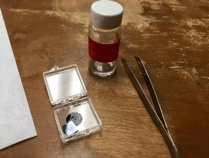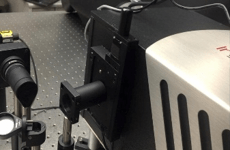Photoluminescence and Photobleaching Studies of Colloidal CdSe Quantum Dots
Student: Chandler Bernard
Major Professor: Dr. Joseph Herzog
Research Area(s):
Photonics
Background/Relevance
- CdSe colloidal Quantum Dots (QDs) exhibit photoluminescence due to their direct band gap structure, and are desirable for applications in both medicine and industry.
- In photoluminescence, an incident photon excites an electron, and a photon with energy equal to the band gap energy is released spontaneously upon relaxation.
- Photobleaching is the drop in intensity of QD emission due to prolonged exposure to laser radiation.
Innovation
- Characterize the effect of varied incident laser powers on photobleaching, emission blueshifting, and mean lifetimes of QDS.
Approach
- Prepare QD samples by dropcasting QDs onto Si Wafer .
- Mount Sample into the Herzog lab’s custom microscope objective.
- Use CMOS camera to isolate individual QDs by looking for blinking (flickering of emitted light).
- Vary 532 nm, 5mW laser’s power using step attenuator.
- Use spectrometer to take 3 spectra per minute for 15 minutes.
- Repeat for 5 QDs per laser power density.


Key Results
- Using photobleaching data, determined that above 8 W/cm2 incident laser power densities, QDs are bleached at around 10 minutes.
- Lifetime is at a maximum at 7.24 W/cm2
- QDs are bleached faster and more severely at higher power densities.
- QDs blueshift more prominently under higher power densities.

Conclusions
- To avoid or mitigate photobleaching, use power densities less than 8 W/cm2
- Maximum lifetime coincides with the laser power density where 33.33% of QDs brightened over 15 minutes instead of bleaching.
- QDs bleach and blueshift faster and more severely under higher power densities.
